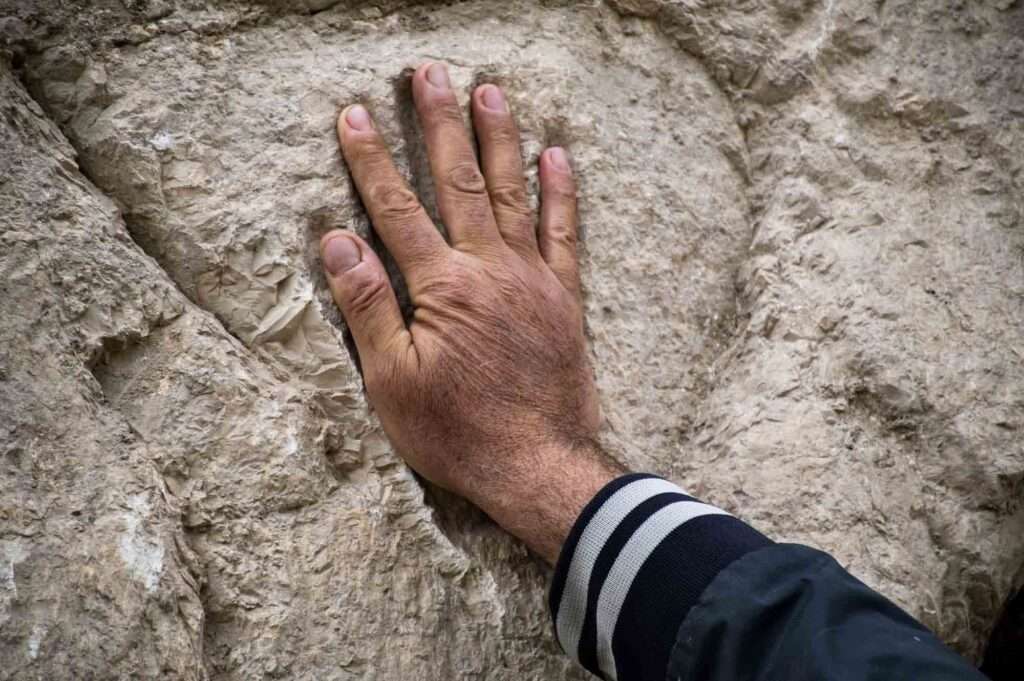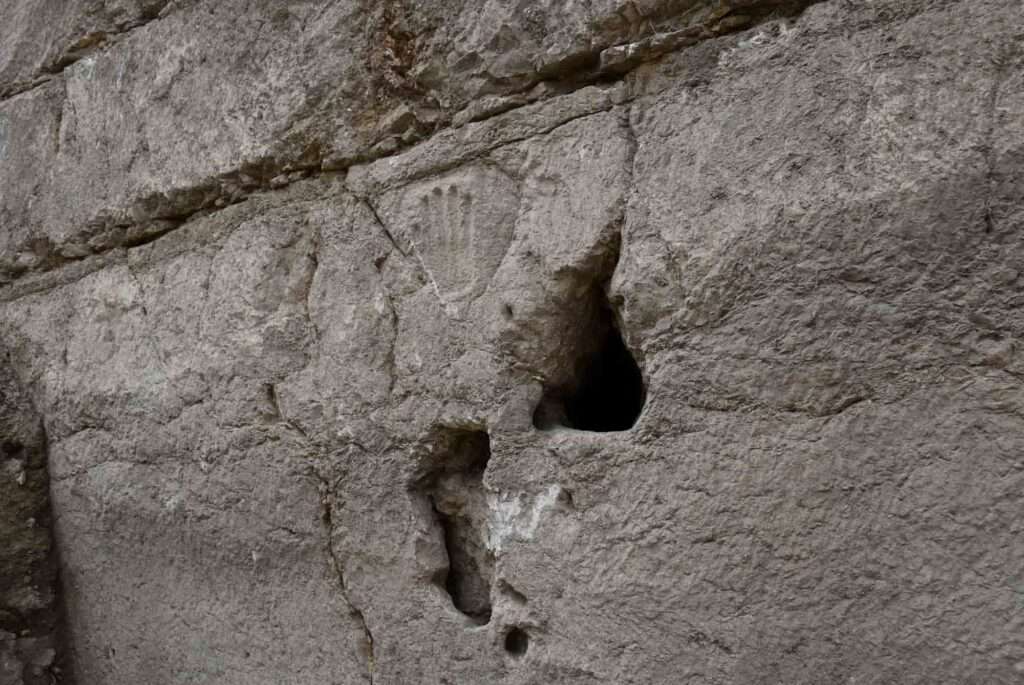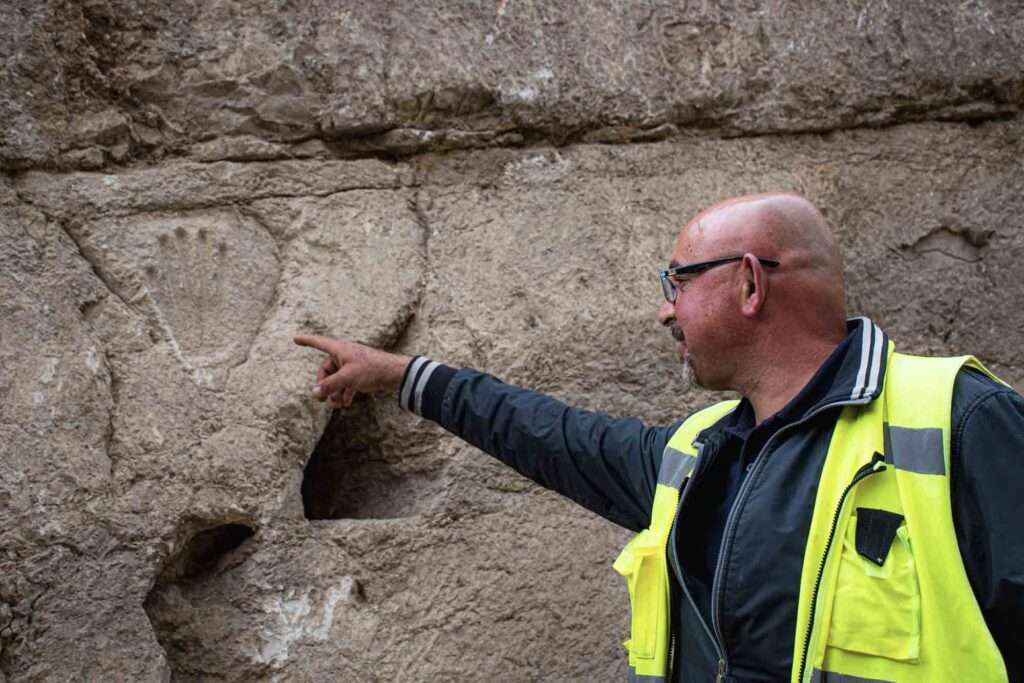At first glance, it seems like the touch of ancvient history reaching out to the future from the 1,000-year-old walls built in Jerusalem to defy the Crusaders.
A handprint left in the defences of the the old city has been unearthed by roadworks around the giant moat that once kept Christian armies at bay.
But the print has baffled historians, who think it might have been left there as an elaborate prank or decoy by the wall’s builders.
For one, it is not actually a print at all but a carefully-carved representation of a human hand.

Experts are trying to work out just what the print signifies. Could it have been a secret sign or direction?
Or could it have been one of the earliest examples of the defenders giving their enemies the finger?
The Israel Antiquities Authority told Newsflash: “A deep 1,000-year-old rock-hewn moat and a mysterious hand imprint were uncovered next to the walls of the Old City of Jerusalem.”
“In the course of the excavations, part of a deep defensive moat that surrounded the city walls, probably dating from the 10th century AD and possibly earlier, were exposed.
“An unexplained carved hand imprint was discovered at one spot carved in the moat wall.”
And baffled researchers investigating the print told local media: “Does it symbolise something?

“Does it point to a specific nearby element? Or is it just a local prank? Time may tell.”
Experts explained how the fort’s defences were built to protect the old city from invaders, including European armies in the Crusades.
The Israel Antiquities Authority explained: “The new elements of the Jerusalem Old City fortification system were discovered in the Israel Antiquities Authority excavations in
Sultan Suleiman street, in the course of infrastructure works carried out by the Moriah – The Jerusalem Development Corporation.”
Zubair Adawi – the authority excavation director – uncovered the moat located just underneath the street.
He said: “People are not aware that this busy street is built directly over a huge moat, an enormous rock-hewn channel, at least 10 m wide, and between 2-7 m deep.
“The moat, surrounding the entire Old City, dates back about 1,000 years to the 10th century AD or earlier, and its function was to prevent the enemy besieging Jerusalem from approaching the walls and breaking into the city.
“Moats, usually filled with water, are well-known from fortifications and castles in Europe, but here the moat was dry, its width and depth presenting an obstacle slowing down the attacking army.”

He went on: “The impressive walls and gates of the Old City visible today were built in the sixteenth century by the Turkish Ottoman Sultan Suleiman I, the Magnificent.”
Dr Amit Re’em – Jerusalem Regional Director at the authority – explained: “The earlier fortification walls that surrounded the ancient city of Jerusalem were much stronger.
“In the eras of knights’ battles, swords, arrows, and charging cavalry, the fortifications of Jerusalem were formidable and complex, comprising walls and elements to hold off large armies storming the city.”
He added: “Armies trying to capture the city in the Middle Ages, had to cross the deep moat and behind it two additional thick fortification walls, whilst the defenders of the city on the walls rained down on them fire and sulfur.
“As if this wasn’t enough, there were secret tunnels in the fortifications, some of them uncovered by the Israel Antiquities Authority archaeologists in previous excavations, whereby the city defenders could emerge into the moat and attack the enemy by surprise, and then disappear back into the city.”
He went on: “The historians who accompanied the First Crusade, describe the arrival of the Crusaders at the walls of Jerusalem in June 1099.

“Exhausted by the journey, they stood opposite the huge moat, and only after five weeks succeeded in crossing it with deploying tactics and at the cost of much blood, under heavy fire from the Moslem and Jewish defenders.”
Antiquities authority director Eli Escuzido, said: “Many dreamed about and fought for Jerusalem, and the city fortifications are a silent testimony. The archaeological finds enable us to visualize the dramatic events and the upheavals that the city underwent.
“One can really imagine the tumult and almost smell the battle smoke.
“We are daily unravelling the intensive military history of the city, and we will make great efforts to exhibit the finds to the general public.”
To find out more about the author, editor or agency that supplied this story – please click below.
Story By: Joseph Golder, Sub-Editor: William McGee, Agency: Newsflash
The Ananova page is created by and dedicated to professional, independent freelance journalists. It is a place for us to showcase our work. When our news is sold to our media partners, we will include the link here.




